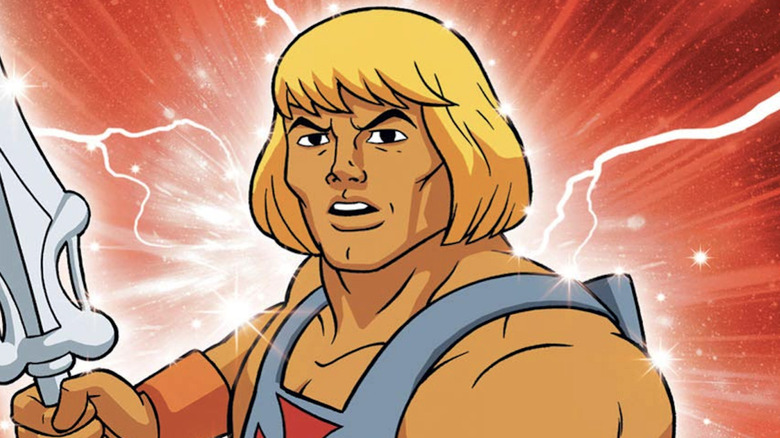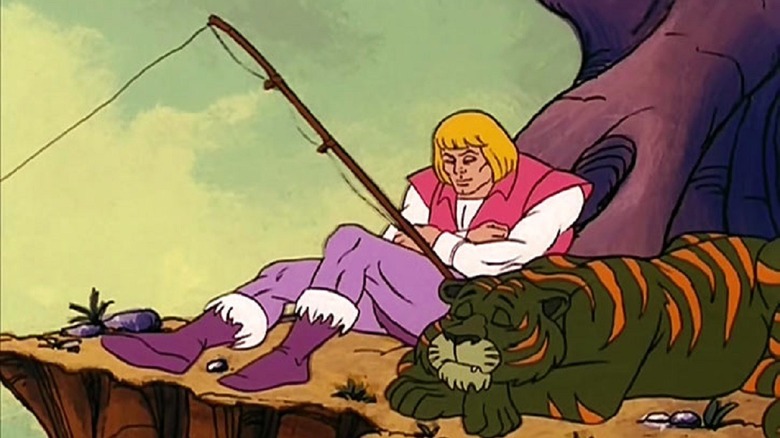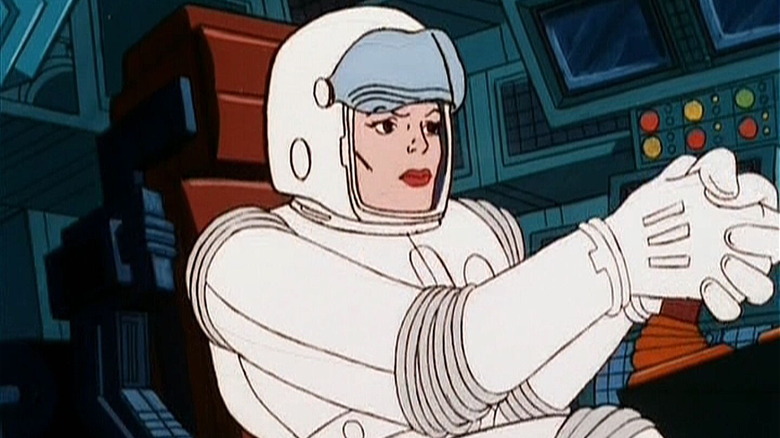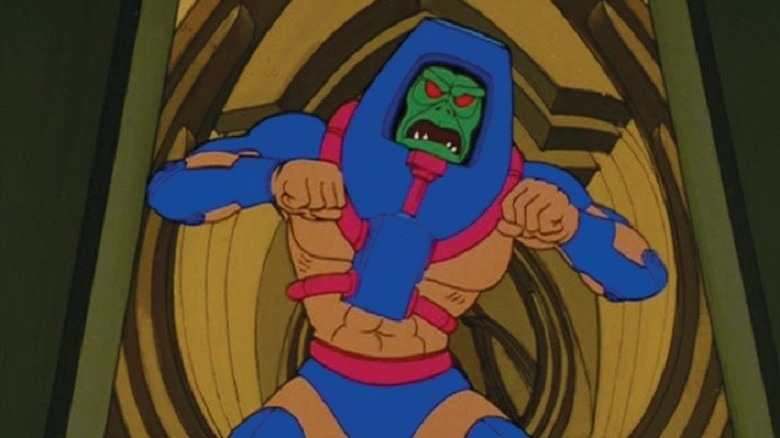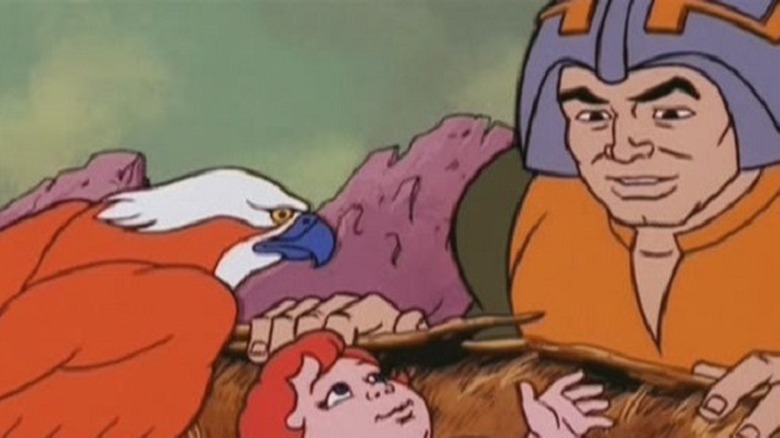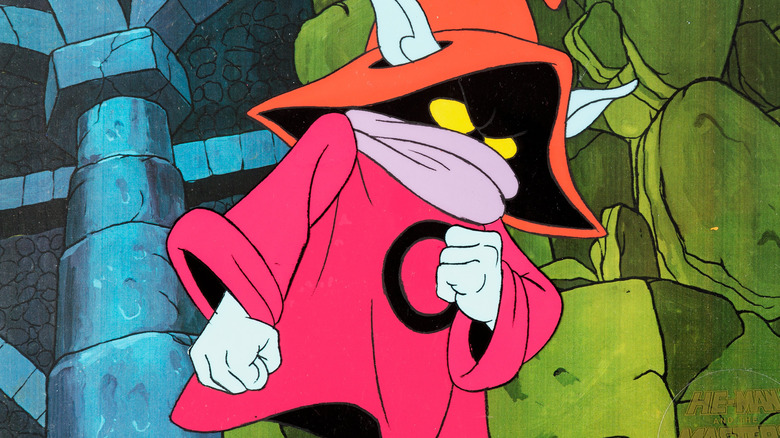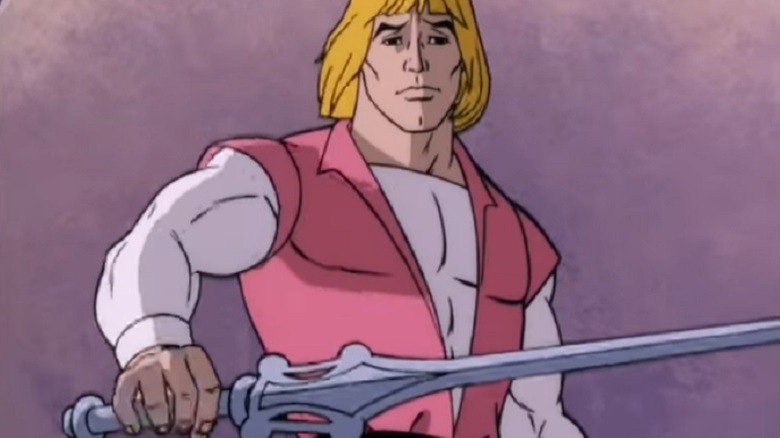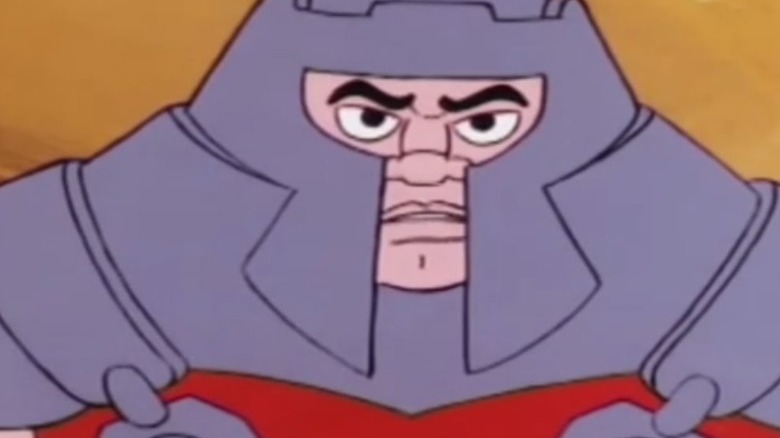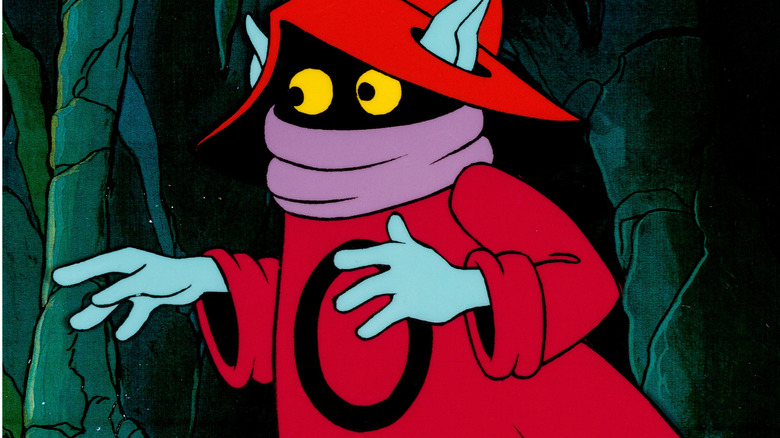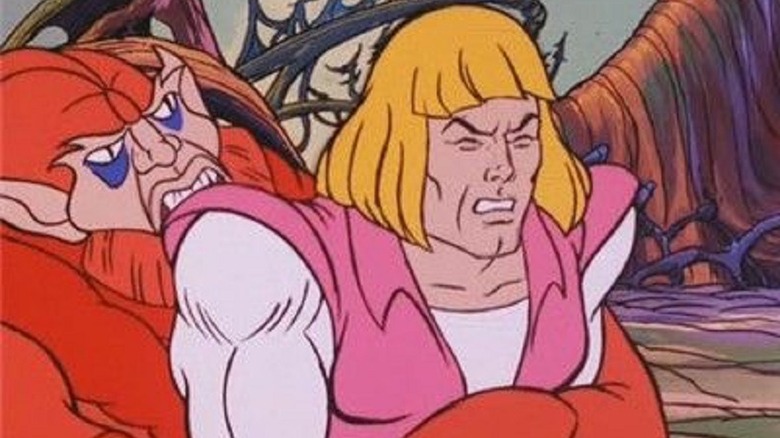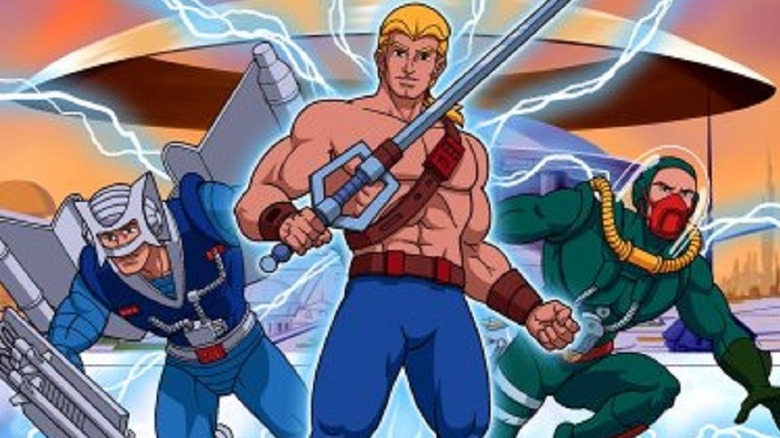Things You Forgot Happened In He-Man And The Masters Of The Universe
He-Man is back and he still has the power! Now that "Masters of the Universe: Revelation" is out on Netflix, many viewers will want to look back at the original show for more musclebound action. Whether these are new fans, eager to see where the legend started in its animated form, or those who grew up with the original show but have forgotten the mysteries Grayskull holds, there is a ton of adventure and fun to be had with the classic cartoon.
Based on a hit toy line from Mattel, "He-Man and the Masters of the Universe" ran for two seasons from 1983-1985, collecting an impressive 130 episodes, a Christmas special, and several crossover adventures with She-Ra. That can be a lot to try and absorb, especially since there are several characters who cycle in and out, as well as one-off heroes and villains that push individual stories, never to return. Somehow, the world of Eternia was not explored very much unless it pertained to that particular episode's narrative, making it harder for newbies to get a handle on where the characters are and why they're fighting.
For those who only have the basic lore down, a few facts might slip through the cracks — leaving plenty of secrets to be rediscovered.
He-Man is cultured
When most people think of He-Man it's about muscles, action, and the fights against Skeletor to save Eternia. Each episode creates a new conflict that sends the hero into battle to help someone or keep the peace — but that can't be all that the titular character does with his time, right?
He-Man was eventually given an alternate identity in the form of Prince Adam within the pages of the comics. This was kept a secret from many of the supporting cast, so that Skeletor couldn't simply kill his foe while he wasn't powered up. But it also gave the character a weakness and created some entertaining story moments when Adam couldn't easily slip away to transform, or had to make excuses to exit a battle so his alter ego could help out.
During the classic show's episodes, viewers are given a few small glimpses into Adam's duties as a member of the royal family: receiving guests, attending events like the joust, and watching performances from Man-E-Faces and other entertainers, as well as other small diplomatic outings. When those duties aren't taking up his free time, the Prince is seen training, or more often opting to skip these lessons with Teela to nap, fish, or even do watercolor paintings. Perhaps if he had been given more time to work on his artistic hobbies, he could have helped create some additional backgrounds for the show.
Queen Marlena isn't from Eternia
For a series that takes place on Eternia (a planet that is not secretly Earth from another time), everyone would be forgiven for assuming there were no Earthlings in the story, but that's not true. The show sees its fair share of people from the planet, mostly in the form of kids (as we saw in the Christmas special), but a couple of members from the main cast are hiding that secret origin as well.
Queen Marlena, He-Man's mother, was originally an astronaut from Earth who was thrown off course after meteors hit her ship, the Rainbow Explorer. This detour to Eternia was supposed to last a few days, but after we are shown a flashback of this in the episode "The Rainbow Warrior," she explains that love took hold instead. This sequence might have meant more had she not dropped a random, "back on Earth," line during the joust earlier, but it's still an intriguing revelation. Marlena gets to show off her piloting skills and save the day in this adventure, while Prince Adam is stuck without his powers, temporarily at least.
This means that Prince Adam is also half-Earthling, and even he (as He-Man) is shocked to see that it was his mother that freed them, meaning it is unlikely many other than King Randor knew much of her past as a captain of the stars. This is also the episode where Queen Marlena not-so-subtly hints that she knows who her son truly is.
The darker side of Man-E-Faces
His name is a cringe-inducing attempt at some sort of pun, but the backstories for the action figures and comics tried to make "Man-E-Faces" more serious, giving him the origin of a tortured actor, transformed by one of Skeletor's potions and given split personalities. The character would make only two main appearances and a couple of cameos, leaving more of an imprint with his gimmick than time on screen. He was originally going to pop in for a side gag in the episode "Into the Abyss," but was cut to help the tone. At least in this version, he was allowed to do more than just three faces.
Those who do recall Man-E-Faces remember him as a hero, fighting alongside He-Man, or at least are aware of his reputation as the greatest actor in Eternia. But in "The Mystery of Man-E-Faces," viewers are also shown that he began on the wrong side of the law, terrorizing people smaller than him, even if he wasn't purely evil. Man-E-Faces tells He-Man that these acts were because others were afraid of him, fearful of his abilities, and shunned him for this. In his own words, this led him to be "cruel" toward everyone and steal from them. After a run-in with Skeletor and Beast Man, who abused him for their own purposes, He-Man and Teela helped free the future actor, and Orko even gave Man-E-Faces his name.
Teela's Parentage
Teela is arguably one of the most interesting characters in the He-Man universe, but having several changes made to her backstory and altering the relationship she shares with the group for various incarnations can make it difficult to keep up with her. In the original minicomics, Teela was a clone of the Sorceress created by Skeletor, an element that was probably inserted to help explain the armor on the original action figure. In other versions, Man-at-Arms is her biological father. There's also a theory that Fisto might actually be her dad, and in the 1983 cartoon Duncan adopts Teela and keeps the identity of her mother a secret, which is revealed in the episode "Teela's Quest."
Here, Teela gets a bit envious of Prince Adam's relationship with Queen Marlena and sets off to find out who her mother really is by seeking the oracle. Being a bit rash, Teela heads off to a dangerous place by herself and runs afoul of Mer-Man and a sea monster, but He-Man shows up to help. She goes through all of this and discovers that her mother is none other than the Sorceress, only to have those memories erased. The knowledge is treated as an incredibly important tidbit that she can't know, but now He-Man is aware of it also. This is brought up one other time in "Teela's Triumph," where she temporarily assumes the role of the sorceress, but not mentioned after that until a 2012 storyline from DC Comics killed off the Sorceress.
Orko's many facets
Many viewers were not fond of Orko. This could be because the character didn't appear in the initial run of the toy line (having been created for the cartoon), or perhaps because he typically played the role of comedic relief. He is the King's Royal Buffoon, after all.
Orko was a klutz, never really able to do his magic correctly, often hindering the heroes on their missions and constantly damaging Man-at-arms' lab. Somehow, he's still one of Prince Adam's closest allies. It isn't surprising that most fans were more upset at the lack of Battle Cat in the live-action film than not seeing Orko.
He's a powerful character – to the point he becomes a villainous mad god in one of the comic storylines – even if he has trouble getting his spells to work properly. As a Trollan, Orko possesses a mastery over matter creation, his hat opens up into a dimensional space where he can keep any number of items, as well as an extra hand comes out of there (which seems helpful), and his teleportation powers allow him to easily escape many traps.
His potent tricks do seem to work somewhat better back in his home dimension, where the laws of physics work differently, and there is a medallion that helps him as well, but some of these points contradict themselves as the show progresses. More importantly, in "Creatures from the Tar Swamp," Orko saves Adam and Cringer at a young age, before they had their powers.
He-Man's sword is a tool, not a weapon
He-Man was originally supposed to wield a battle-ax back when he was in toy form, but looking back now, he wouldn't seem right without his Power Sword.
The "Masters of the Universe" toys also came with two swords (one belonged to Skeletor), and these had to be put together to unlock Castle Grayskull. In the '80s, however, shows came under fire from parent groups and politicians alike, prepared to blame much of society's ills on the pop culture of the day. As pre-emptive measures, Skeletor got a staff, He-Man held back on his swordplay, and other creative decisions were made to walk a tightrope ensuring that the series could be kid-friendly, yet still be appealing to kids.
He-Man barely uses his fists, let alone his sword, and most of his aggressive actions are levied against large monsters or robots. Whenever the hero is dealing with humanoid-type characters, his tactics become more about subduing the enemies. His preferred method is usually to throw large rocks, or simply to pick the perpetrator up and toss them — if you look for it, you'll notice that He-Man spends a lot of time throwing others off-screen.
There are a few times when He-Man will chuck his sword at larger monsters – but even if the blade hits, it almost always bounces off them. He isn't allowed to use the sword against anyone offensively to any effective degree, and most of the time he's seen using it to cut items or deflect laser blasts.
He-Man went hard on the PSAs
Public Service Announcements (PSAs) have a long and complicated history that can arguably be traced back to the Civil War, but Filmation is often mentioned for modernizing these messages with their work on "Fat Albert and the Cosby Kids" and "He-Man." The latter almost had to have these little lessons with how closely parents related the show to violence, and the producers tried hard to balance out the program. Running 130 episodes, the show covered a lot of ground with these messages, so it makes sense that they don't all land quite right. A few are uncomfortable and others are just plain silly.
Consider, for instance, the PSA that had Ram Man telling kids not to run their heads into things. Or another that had Ram Man and Man-E-faces making up after an argument.
Additionally, there were episodes about drugs, so those PSAs were present, and one PSA about inappropriate touching, but it went further to tell kids that they shouldn't feel ashamed if it happened. These ending sections also tried to warn children about being ageist, judging people based on their appearances, not to take shortcuts for wealth and power, accepting failures and learning from mistakes. Within the episodes themselves were some solid examples of needing to have faith and that even He-Man can lose his confidence, which the creators say paid off based on stories fans told them years later. They crammed a ton of valuable information into the show for those who were listening, and then there were straightforward points, like Teela telling audiences about the Magna Carta.
How money changes someone
It's no secret that Filmation was banking on "He-Man and the Masters of the Universe" to help put the company on the map, and to make sure everything worked out the way they wanted it to, costs had to be kept low. This pride in an American-made show kept under budget lead to cuts all around, with voice acting and animation taking the largest hits. As anyone who watches the show can hear, various small characters have familiar voices, and zoomed-in shots frequently take the place of actual animation, as reused assets, rewound motions, and replayed sequences became the norm.
Speaking of cutting corners, the character of Orko originally had another name, Gorpo, which can still be heard in some Portuguese translations of the show. This late alteration seems to come from a financial standpoint instead of a creative one, because if the character had a large letter G imprinted on his clothing, it would be harder to flip footage of him and make scenes look different without having to re-draw the floating magician. The giant O, however, helped with this and looked more mystical on the Trollan. This brings into question how many other changes might have happened all in the name of saving a few dollars, even if Orko is the better name.
Some great people worked on the show
Most folks don't think of great writing or production value when recalling "He-Man and the Masters of the Universe," but the truth is that the program had some incredibly skilled behind-the-scenes talent.
Not only was there a tremendous group of voice actors who brought the characters to life – many of them having to talk to themselves in a majority of the scenes – but other voices had to be filled in by one of the founders of Filmation, Lou Scheimer, as well as his wife, and daughter, making that a tightknit group. The energetic music was handled by Haim Saban and Shuki Levy, giants with stellar resumes in the world of children's programming.
Behind the scenes was Bruce Timm, now known as the mind behind some of DC Comics' greatest animated projects. One of his earliest gigs was as a background artist and designer for "He-Man," while he was also given a chance to work with the mini-comics.
Some of his fellow comic book brethren were present to help on scripts, with Paul Dini and J. Michael Straczynski working on the show early in their careers. "Star Trek" scribe D.C. Fontana contributed an episode featuring the origin of Battle Cat as well. Even if children's show trappings restricted what could be done, no one could ever say that He-Man didn't have a wealth of talent behind him.
There was a 1990 follow-up cartoon
"Masters of the Universe: Revelation" is attempting to give fans a proper continuation to the '80s cartoon, but it's not the first time this has been attempted.
Although rarely remembered, there was an attempt at a direct sequel that mutated into its own strange oddity. Sales for the toy line had begun to decline drastically by 1986, and it was evident that the franchise needed some sort of rejuvenation. This came in the form of a redesigned set of toys, which would require a new show to help sell them like last time. Enter "The New Adventures of He-Man."
This show uprooted Adam from Eternia, placing him instead on the ultra-high-tech planet Primus. Leaving most of the cast behind (some would occasionally cameo), Skeletor did tag along to remain his nagging nemesis.
This near-complete re-haul of He-Man featured a protagonist that didn't look like the musclebound warrior kids were accustomed to seeing, as well as one of the worst designs for Skeletor. Other than the upgraded visuals, almost everything else was worse, and the show is often remembered (if at all) as the weakest of the franchise.
Somehow, "New Adventures" ran for 65 episodes. There were rumors of a second season that would send Adam back to Eternia, but instead the '90s led He-Man into relative obscurity. With "Masters of the Universe: Revelation," perhaps it is finally time once again for He-Man to have the power.
